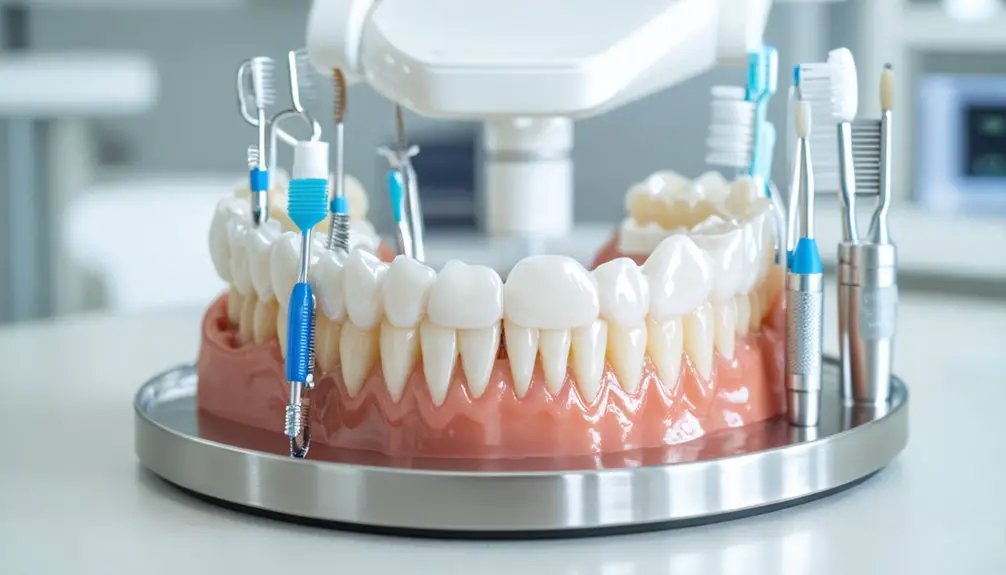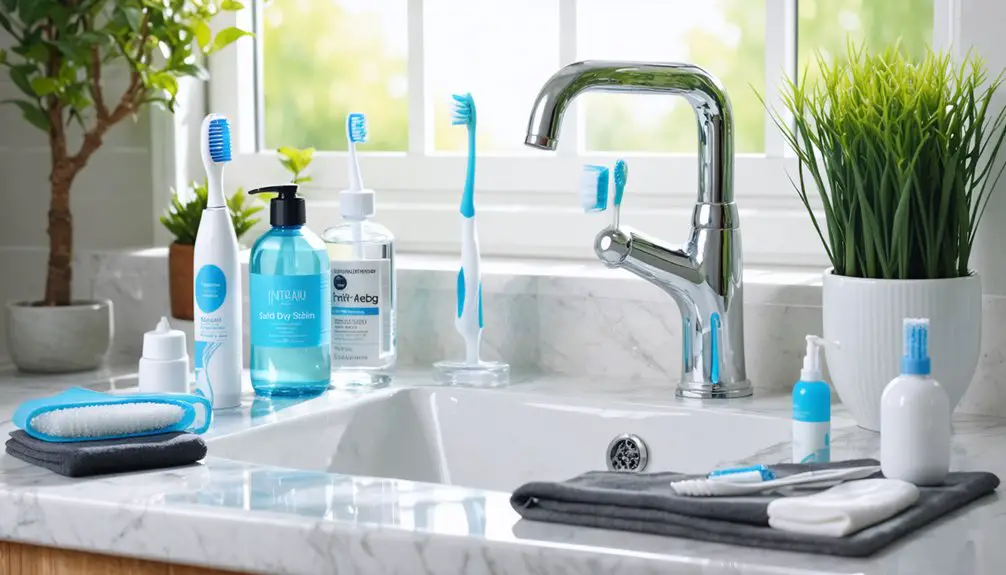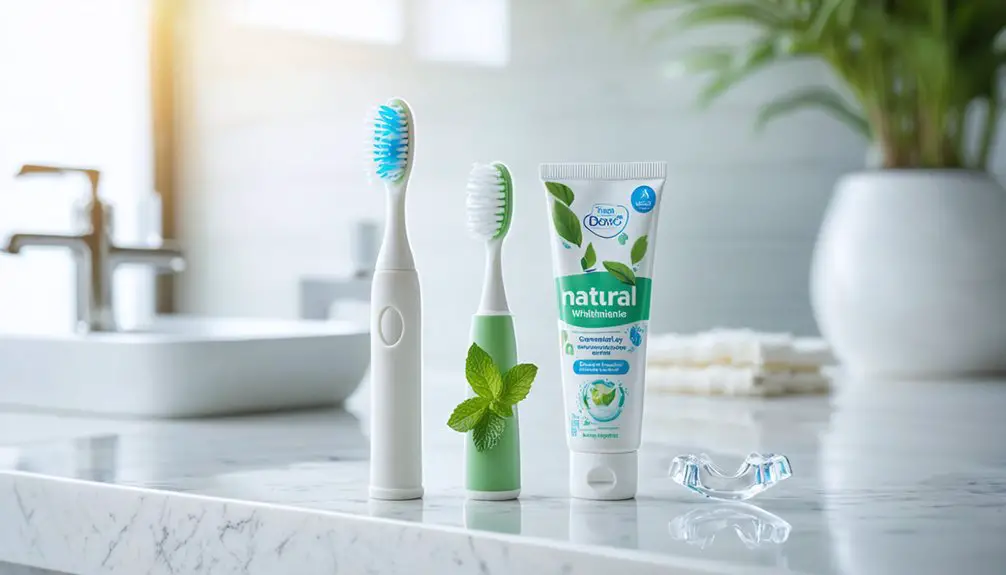You can safely whiten your teeth at home by following proven application guidelines and time limits. Limit whitening gel exposure to 30-60 minutes per session, and never exceed 14 days of consecutive treatment. Use products with regulated peroxide concentrations, monitor for sensitivity, and protect your gums from chemical contact. For ideal results, combine natural methods like oil pulling with proper oral hygiene. Understanding the vital differences between treatment options will help maximize your whitening success.
Key Takeaways
- Follow manufacturer instructions strictly and never exceed 30 minutes per session or 14 days of consecutive treatment to prevent enamel damage.
- Use products with regulated peroxide concentrations and look for enamel-safe labels to minimize sensitivity and gum irritation.
- Apply desensitizing toothpaste two weeks before and after treatment, and avoid hot and cold foods for 48 hours post-whitening.
- Protect gums by using custom-fit trays or professional-grade barriers, and stop treatment if experiencing redness or discomfort.
- Space whitening sessions 6-12 months apart to allow proper enamel recovery and maintain results through good oral hygiene.
Understanding Natural vs. Chemical Teeth Whitening Methods
While both natural and chemical teeth whitening methods aim to brighten your smile, they operate through distinctly different mechanisms and yield varying results.
Natural whitening approaches like oil pulling, baking soda, and activated charcoal primarily target surface stains through gentle abrasion and bacterial reduction. These methods offer gradual improvements with minimal risk when used properly. When using baking soda, patients should expect gradual teeth improvement rather than instant results. Crunchy fruits and vegetables can serve as natural scrubbers while promoting overall dental health.
Natural teeth whitening relies on gentle yet effective methods to remove surface stains, offering safe and steady progress toward a brighter smile.
In chemical contrast, professional whitening products penetrate deeper into tooth structure, actively changing intrinsic coloration through oxidation. While more effective, they can cause increased sensitivity and gum irritation.
You’ll find that natural methods, though slower-acting, support long-term oral health when combined with proper diet and hygiene practices. Understanding these differences helps you make informed decisions about which approach best serves your patients’ needs while protecting their enamel integrity.
Safe Usage of Over-the-Counter Whitening Products
To protect your dental health when using over-the-counter whitening products, you’ll need to strictly follow the manufacturer’s recommended application times, which typically range from 5 to 30 minutes depending on the product’s concentration.
Products containing bleaching agents like hydrogen peroxide or carbamide peroxide can deliver noticeable whitening results when used correctly.
If you experience tooth sensitivity during treatment, you can reduce application duration or take breaks between sessions while maintaining proper usage protocols. Long-term overuse of whitening products can cause permanent enamel damage that cannot be reversed.
You should immediately discontinue use and consult a dental professional if you develop severe sensitivity, persistent gum irritation, or uneven whitening results.
Proper Application Time Limits
Since over-the-counter whitening products contain lower concentrations of active ingredients than professional treatments, proper timing of their application becomes essential for both safety and effectiveness.
Your application techniques should align with established timing strategies to achieve ideal results while minimizing potential risks.
- Limit strip and gel applications to 30 minutes, twice daily, and don’t exceed the recommended 14-day treatment period.
- Monitor your exposure time carefully, as extending beyond manufacturer guidelines won’t accelerate results but may increase sensitivity.
- Schedule maintenance treatments at appropriate intervals – typically every 6 months – to sustain whitening effects without compromising enamel integrity.
Professional in-office treatments can achieve dramatic improvements in just 60 to 90 minutes per session. Using professional-grade hydrogen peroxide solutions, these treatments provide longer-lasting results compared to at-home options.
If you experience any sensitivity or gum irritation, discontinue use immediately and consult your dental professional for guidance on adjusting your whitening protocol.
Sensitivity Prevention During Treatment
Because tooth sensitivity commonly occurs during whitening treatments, implementing preventive measures before and during the process can greatly reduce discomfort.
Start using desensitizing toothpaste two weeks before treatment and continue for at least a week afterward to block nerve pathways and fill exposed dentin tubules. Using products with lower peroxide levels can minimize potential sensitivity during whitening. Consider professional fluoride treatments to strengthen your enamel and enhance its resistance to sensitivity.
During treatment, avoid hot and cold foods or beverages for 48 hours post-whitening, as temperature extremes can trigger nerve discomfort. If needed, make slight timing adjustments to your whitening sessions to minimize sensitivity.
Steer clear of acidic and sugary substances that can erode enamel and heighten sensitivity. Instead, opt for room-temperature, neutral foods like milk, cheese, or bananas.
If sensitivity occurs, apply sensitivity gels as directed and use a soft-bristled toothbrush for gentle cleaning.
Common Risks and Side Effects to Watch For
While teeth whitening has become increasingly popular for achieving a brighter smile, it’s important to understand the potential risks and side effects that can occur during home treatment.
You’ll need to monitor your sensitivity management and gum health carefully throughout the process to prevent complications.
- Watch for tooth sensitivity to hot, cold, or sweet stimuli, which typically subsides within a week but may require desensitizing products if persistent.
- Monitor your gums for signs of irritation, including redness, swelling, or soreness, which can occur if whitening agents make contact with soft tissues.
- Be alert for uneven whitening or patchy results, particularly if you have dental restorations, as these won’t respond to bleaching agents.
Following instructions carefully and using peroxide-based agents correctly is essential for breaking down stains effectively while minimizing risks.
Professional treatments provide lasting results up to 2-3 years compared to shorter-term effects from home whitening.
If you experience severe or prolonged discomfort, consult your dental professional immediately to prevent potential enamel damage.
Best Practices for Oil Pulling and Baking Soda Methods
Natural teeth whitening methods like oil pulling and baking soda treatments offer cost-effective alternatives to commercial products, though proper technique remains essential for best results and safety.
For oil pulling, swish one tablespoon of high-quality coconut, sesame, or sunflower oil for 15-20 minutes on an empty stomach. Don’t swallow the oil, as it contains accumulated bacteria. Follow with regular brushing and flossing.
When using baking soda, dilute it with water or mix into fluoride toothpaste to create a gentle abrasive paste. Limit applications to once or twice weekly to prevent enamel erosion. Rinse thoroughly afterward to neutralize alkalinity.
Both methods should supplement, not replace, professional dental care. If you experience sensitivity or discomfort, discontinue use and consult your dental professional.
Proven Techniques for Long-Lasting Results
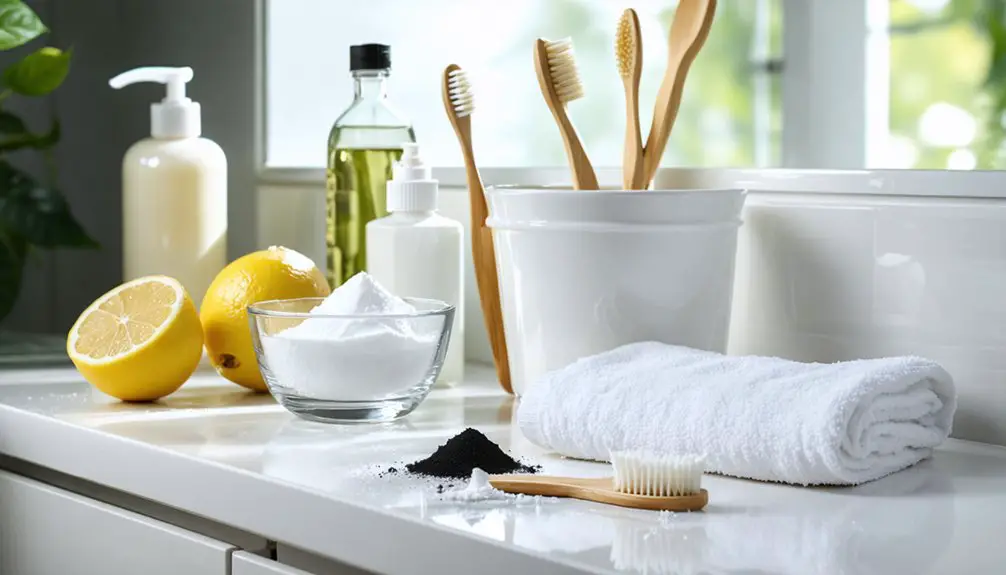
To achieve long-lasting teeth whitening results, you’ll need to combine proven over-the-counter products with consistent oral hygiene practices.
While natural remedies and whitening myths abound, scientific evidence supports the effectiveness of products containing hydrogen peroxide or carbamide peroxide in concentrations between 10-20%.
- Select appropriate whitening products based on your dental profile, avoiding experimentation that could damage sensitive teeth or existing restorations.
- Maintain strict adherence to application protocols, using strips or gels as directed while monitoring for sensitivity.
- Support your whitening regimen by minimizing stain-causing beverages, implementing protective measures like drinking through straws, and increasing consumption of naturally cleansing foods.
Supplement your routine with diluted hydrogen peroxide mouthwash and professional dental cleanings to preserve your results effectively.
Protecting Your Enamel During Whitening
When whitening your teeth at home, select clinically-proven methods like dentist-prescribed kits or ADA-approved products that prioritize enamel protection while delivering results.
You’ll need to track treatment times meticulously, never exceeding recommended durations, as overexposure to whitening agents can permanently damage your enamel’s protective structure.
To safeguard your oral tissues during treatment, apply protective barriers to your gums and guarantee whitening agents contact only the tooth surfaces you intend to brighten.
Choose Safe Whitening Methods
Selecting safe teeth whitening methods requires careful consideration of both active ingredients and application techniques to protect your enamel’s integrity.
Natural remedies like coconut oil pulling and properly diluted baking soda offer gentle alternatives that preserve enamel safety while gradually improving tooth appearance.
- Choose whitening products containing 10-20% carbamide peroxide, which provides ideal results while minimizing enamel sensitivity and potential damage.
- Utilize fluoride-enhanced whitening systems containing potassium nitrate to support remineralization and reduce nerve sensitivity during treatment.
- Implement custom-fitted trays or professional-grade strips that guarantee controlled application of whitening agents while protecting surrounding soft tissues.
Avoid acidic DIY solutions, particularly those containing lemon juice or undiluted hydrogen peroxide, as these can irreversibly damage your enamel structure despite their perceived effectiveness.
Monitor Treatment Duration Carefully
Safe whitening results depend heavily on precise timing and duration control of your treatment applications.
For ideal product effectiveness while protecting your enamel, limit at-home whitening gel exposure to 30-60 minutes per session. If you’re using over-the-counter products with 2-3% hydrogen peroxide concentration, you can safely extend duration up to 2 hours if no sensitivity occurs.
Maintain proper treatment intervals by spacing sessions 6-12 months apart to allow enamel recovery.
For professional-grade products containing 25-40% peroxide, strictly adhere to the 15-20 minute limit under dental supervision. Always remove excess gel promptly after treatment, and consider using remineralizing products between sessions.
If you experience tooth sensitivity, immediately reduce exposure time or pause treatments to protect your enamel integrity.
Apply Protective Gum Barriers
Protective gum barriers serve as a critical defense mechanism during teeth whitening treatments by preventing peroxide-based bleaching agents from damaging sensitive oral tissues.
You’ll find significant gum barrier benefits when properly applying this resin-based protective shield to maintain oral health during whitening procedures.
For ideal protection, follow these essential application techniques:
- Clean and isolate the treatment area using cheek retractors and cotton rolls.
- Apply the barrier gel precisely along the gum line using a syringe or brush, ensuring 2-4mm thickness.
- Cure the protective material with an LED light for 10-40 seconds until completely hardened.
This physical barrier effectively blocks whitening agents from penetrating soft tissue, reducing your risk of chemical burns, inflammation, and discomfort while allowing the bleaching process to focus solely on your tooth enamel.
Diet Changes That Support Whiter Teeth
Making strategic dietary choices can greatly enhance your teeth whitening efforts through natural mechanical and chemical processes.
You’ll find powerful fiber benefits in crunchy vegetables like cauliflower, celery, and carrots, which act as natural scrubbers while stimulating saliva production to wash away stains. Fruits containing malic acid, particularly strawberries and apples, serve as natural bleaching agents.
Incorporate dairy products regularly, as their calcium and lactic acid strengthen enamel while creating a protective barrier against stains.
You’ll boost whitening results by including nuts and seeds, which provide gentle abrasive action to remove surface discoloration.
For best results, combine these dietary changes with proper oral hygiene, ensuring you’re maximizing both the mechanical cleaning and chemical whitening properties these foods offer.
When to Choose Professional vs. Home Treatments
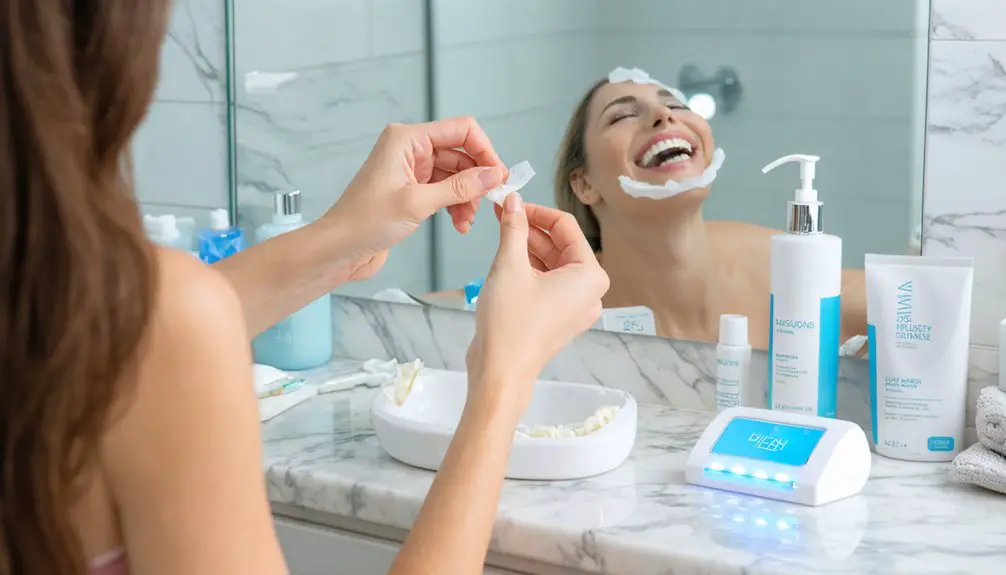
Beyond dietary improvements, selecting the appropriate whitening method requires careful consideration of several clinical factors.
Professional treatments utilize 25-40% hydrogen peroxide concentrations for rapid results, while at-home kits contain 3-10% for gradual improvement. Your choice should align with specific oral health needs and aesthetic goals.
Professional whitening delivers fast results with 25-40% peroxide, while home kits offer gentler progress at 3-10%. Choose based on your needs.
- Select professional treatments when addressing stubborn stains, requiring dramatic results within hours, or preparing for special occasions – though costs range from $350-$1200.
- Choose at-home kits for mild discoloration, maintenance after professional services, or when seeking affordable options around $50.
- Consider professional take-home systems with custom trays as a middle ground, combining prescription-strength efficacy with application flexibility.
Always assess your tooth sensitivity and existing enamel condition before proceeding with any whitening regiment.
Essential Safety Guidelines for DIY Whitening
Before starting any DIY teeth whitening treatment, you’ll need to verify the active ingredients and peroxide concentrations to guarantee they fall within the safe 10-20% range.
You must carefully time each treatment session according to the product instructions, never exceeding recommended durations to prevent enamel damage.
Your gum tissue requires protection during whitening applications, so use protective gels or properly fitted trays to minimize contact between whitening agents and soft tissues.
Know Your Product Ingredients
Safe teeth whitening starts with understanding the active ingredients in whitening products and their potential risks.
Product transparency and ingredient sourcing are essential when selecting whitening treatments, as many over-the-counter options contain undisclosed concentrations of harmful substances.
- Examine labels for hydrogen peroxide and carbamide peroxide concentrations, as these primary whitening agents can cause sensitivity and gum irritation if improperly dosed.
- Avoid products containing abrasive ingredients like baking soda, acidic components such as lemon juice, or harsh chemicals like sodium chlorite and ammonium hydroxide.
- Choose products specifically labeled “enamel safe” and avoid DIY mixtures with unregulated ingredients that can permanently damage your dental health.
Remember that professional-grade whitening products offer controlled formulations that minimize risks while maximizing results.
Monitor Treatment Duration Carefully
When undertaking at-home teeth whitening treatments, precise timing and duration management are critical factors that determine both safety and efficacy.
Start with 30-minute sessions, only extending to one hour if you don’t experience sensitivity. Never exceed two hours, even for stubborn stains.
Monitor your treatment frequency carefully, maintaining 6-12 month intervals between whitening sessions.
The gel concentration in your product directly impacts safe duration limits – higher concentrations require shorter application times. For products with 2-3% hydrogen peroxide, you’ll have more flexibility, while 10% concentrations demand stricter adherence to timing guidelines.
Remove all excess gel immediately after treatment to prevent chemical burns.
If you notice any sensitivity, reduce your treatment duration or stop entirely until symptoms subside.
Protect Gums While Whitening
Proper gum protection stands as the cornerstone of safe at-home teeth whitening procedures. To minimize gum irritation, you’ll need to implement specific protective measures when applying whitening agents.
Using custom-fit trays and proper isolation techniques prevents whitening gel from contacting sensitive gum tissue.
- Apply a professional-grade gingival barrier along your gumline before treatment, creating a protective shield against peroxide penetration.
- Position cotton rolls and gauze strategically to maintain a dry working surface and prevent gel migration onto soft tissues.
- Select lower concentration peroxide products initially, especially if you have a history of sensitivity.
Monitor your gums for signs of redness or discomfort during treatment. If irritation occurs, discontinue use immediately and consult your dental professional.
Maintain thorough oral hygiene practices before and after whitening sessions to support ideal gum health.
Maintaining Results Without Damaging Teeth
Maintaining your teeth whitening results requires a balanced approach between effective oral care and protective measures to prevent enamel damage.
Monitor your whitening frequency carefully, using touch-up treatments only when necessary to avoid enamel sensitivity and wear.
Brush twice daily with fluoride toothpaste and a soft-bristled brush, limiting whitening toothpaste to a few times weekly.
Regular brushing with fluoride toothpaste protects your smile, but use whitening products sparingly to maintain healthy enamel and lasting results.
Protect your results by avoiding staining substances like coffee, tea, and red wine. When you do consume these items, rinse immediately with water to minimize contact time.
Schedule professional cleanings every six months to remove stubborn stains and maintain oral health.
Follow your dentist’s guidance on safe whitening products and intervals.
Drink plenty of water throughout the day to neutralize acids and protect your enamel’s integrity.
Frequently Asked Questions
Can Whitening Treatments Fix Fluorosis Stains on Teeth?
Picture those chalky white spots on your teeth. While whitening treatments can improve fluorosis stains, they’re not fully effective alone. You’ll likely need professional sodium hypochlorite bleaching for significant improvement.
How Long Should I Wait After Teeth Cleaning Before Starting Whitening?
You’ll need to wait at least 24 hours after teeth cleaning before starting whitening treatments. If you’ve had dental restorations, extend this timeline to 2-4 weeks for ideal safety and effectiveness.
Are Whitening Products Safe to Use With Composite Bonding Materials?
You’d think whitening products would work on everything, but they won’t affect your composite bonding. While safe to use, they’ll only whiten natural teeth, potentially creating noticeable shade differences with bonded areas.
Can Taking Certain Medications Affect the Outcome of Teeth Whitening?
Yes, certain medications can greatly impact whitening effectiveness through medication interactions that cause intrinsic staining, reduce saliva production, or alter your oral environment, making teeth more resistant to bleaching treatments.
Does Activated Charcoal Actually Work for Whitening Without Damaging Teeth?
Research shows activated charcoal’s effectiveness for whitening is minimal and unsatisfactory. You’ll risk enamel damage from its high abrasiveness. For your dental health, choose professionally-recommended peroxide-based whitening products instead.
References
- https://www.healthline.com/nutrition/whiten-teeth-naturally
- https://www.webmd.com/oral-health/teeth-whitening
- https://newsnetwork.mayoclinic.org/discussion/mayo-clinic-q-and-a-many-safe-choices-available-to-help-whiten-teeth/
- https://www.healthpartners.com/blog/safe-teeth-whitening/
- https://pmc.ncbi.nlm.nih.gov/articles/PMC4058574/
- https://pmc.ncbi.nlm.nih.gov/articles/PMC10024105/
- https://www.luriedental.com/dental-services/cosmetic/blog/do-natural-teeth-whitening-remedies-really-work
- https://www.medicalnewstoday.com/articles/322421
- https://www.eastquarterdental.com/2025/05/09/the-dangers-of-over-the-counter-teeth-whitening/
- https://valerysweenydds.com/the-hidden-dangers-of-over-the-counter-teeth-whitening-kits/

